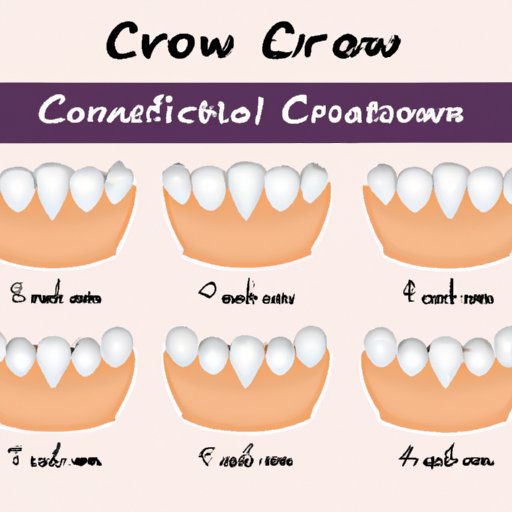Introduction
When it comes to dental procedures, there are many terms patients might not be familiar with. One such term is “dental crown.” This dental restoration is used to treat a range of dental issues and can help restore a damaged or worn-down tooth. In this article, we’ll take an in-depth look at dental crowns and what makes them an essential tool in modern dentistry.
Understanding the Purpose of Dental Crowns: A Comprehensive Guide
A dental crown is a tooth-shaped cap that is placed over an existing tooth. They are designed to strengthen the tooth, improve its appearance, and improve its overall function. Dental crowns cover the entire visible portion of the tooth above the gumline.
The purpose of dental crowns is to provide a protective cap over damaged, worn-down, or broken teeth. Crowns are used to restore teeth that have undergone significant decay or grinding that can’t be corrected by filling. They are also used for patients who have undergone a root canal because the procedure typically weakens the tooth.
Common scenarios that require a dental crown include:
- Protecting a weak or decaying tooth from breaking or fracturing
- Restoring a broken or severely worn-down tooth
- Supporting a tooth that has a large filling and not enough tooth remaining
- Covering a misshapen or discolored tooth that affects an individual’s smile
- Holding a dental bridge in place
- Covering a dental implant
One important aspect is that dental crowns are not permanent, but they last for a long time if cared for properly and with adequate oral hygiene.
The Beauty and Functionality of Dental Crowns Explained
Many people think of dental crowns as a purely cosmetic procedure. While the improvement in appearance can be an added bonus, the functional benefits of dental crowns can’t be overlooked.
Firstly, dental crowns provide protection and support to damaged teeth. This additional support allows for better biting and chewing and helps alleviate any discomfort or sensitivity that might have existed previously. Furthermore, dental crowns also serve as a barrier against bacteria and plaque build-up, substantially reducing the chances of developing tooth decay under the crown.
There are different materials available for dental crowns, including porcelain, ceramic, metal, resin, and ceramic fused to metal (PFM). Porcelain crowns and ceramic crowns are popular choices because they mimic the natural appearance of teeth while offering durability and strength. Metal crowns are stronger than porcelain or ceramic crowns, but their metallic appearance can be a turnoff for some patients. PFM crowns are a good compromise, as they combine the strength of metal with the natural appearance of porcelain or ceramic.
Everything You Need to Know About Crowns: From Procedure to Aftercare
If you require a dental crown, you might be wondering what to expect during the procedure and how to care for your new crown once it’s in place.
The process of receiving a dental crown typically involves:
- Removal of any decay, if present
- Reshaping the tooth to prepare it for the crown
- An impression or X-ray of your teeth where the crown will be placed
- A temporary crown to be placed until the permanent crown is ready
- Placement of the permanent crown
Recovery from a dental crown procedure should be minimally painful and only involves mild sensitivity. You should avoid eating hard and sticky foods for any discomfort after the operation. It is also advisable to brush and floss your new crown carefully, and avoid consuming an excess of heavily pigmented foods and beverages that can stain your new crown.
The Top 5 Benefits of Dental Crowns for Restoring Damaged Teeth
As outlined above, dental crowns can serve several functions, from protecting your teeth to improving their appearance. Here are the top benefits of dental crowns:
- Strengthen your teeth
- Re-establish chewing function
- Protect your teeth from further damage or decay
- Rebuild your smile
- Improve overall dental health by promoting oral hygiene
A Complete Breakdown of Dental Crowns: When to Consider Them, Types Available, and Average Cost
Finally, it is essential to understand when to consider dental crowns, the different types available, and the average cost.
The most common types of dental crowns include:
- Metal
- Porcelain-fused-to-metal (PFM)
- Porcelain
- Ceramic
When considering the different types of dental crowns, factors to consider include durability, aesthetics, and cost. Metal crowns are durable, and they are typically the most affordable option. Porcelain and ceramic crowns, on the other hand, are more aesthetically pleasing but can be more expensive. Lastly, PFM crowns offer a balance between strength and appearance.
The average cost of a dental crown in the United States ranges between $500 and $1500 per tooth. The cost will vary depending on the location, type of crown, and professional performing the operation. It’s always important to check with your insurance provider to find out whether or not they provide coverage for dental procedures.
Conclusion
Dental crowns are an essential tool in modern dentistry, providing both functional and cosmetic benefits. Whether you need a crown to restore a damaged tooth or improve its appearance, understanding the types, methods, and costs involved can help you make an informed decision. Always remember to care for your new crown with good oral hygiene to ensure that it is long-lasting and functional.
For those experiencing dental issues, it’s best to seek out professional dental care for diagnosis and treatment decisions, so don’t hesitate to book an appointment.
